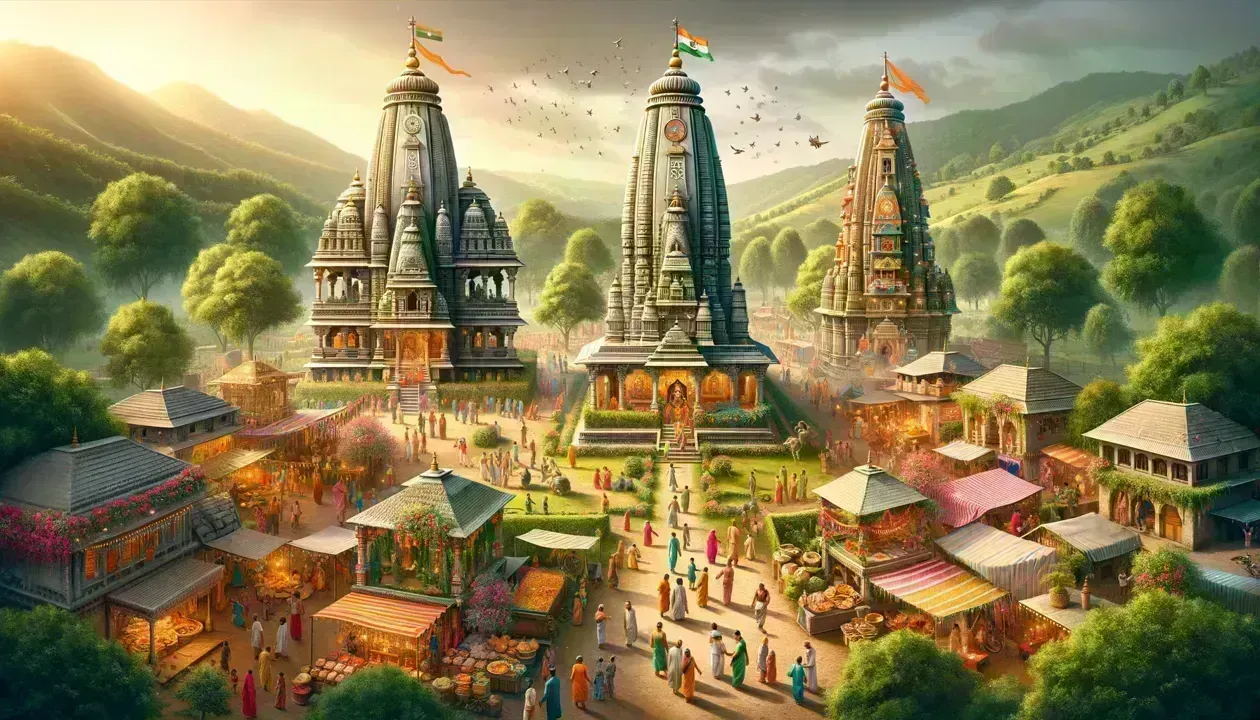
Journey Through Shiv Temple, Kanjka Da Mandir, and Village Fairs
Nestled amidst the serene landscapes, this village has garnered fame across neighbouring regions, thanks to its two historic temples: the Shiv Temple and the Kanjka Da Mandir. These temples are not only places of worship but also centres of vibrant cultural activities that bring together the community in celebration and reverence.
The Historic Shiv Temple
The Shiv Temple stands as a remarkable testament to the village's rich spiritual heritage and architectural prowess. Dedicated to Lord Shiva, one of the principal deities in Hinduism, this temple has been a beacon of faith and devotion for centuries. Its historical significance and architectural beauty make it a revered pilgrimage site, drawing devotees from near and far.
Architectural Marvel
The Shiv Temple's architecture is a splendid blend of ancient craftsmanship and spiritual symbolism. The temple is built in the traditional Nagara style, characterised by its towering spire (shikhara) and intricate carvings that adorn its façade. Every inch of the temple's exterior is covered with detailed sculptures depicting scenes from Hindu mythology, primarily focusing on Lord Shiva's various forms and stories.
The entrance to the temple is marked by a grand gateway (torana) that features elaborate carvings of deities and mythical creatures, symbolising the divine protection over the sacred space. As devotees pass through the gateway, they are greeted by the sight of beautifully carved pillars that lead to the main sanctum (garbhagriha).
Sanctum Sanctorum
The sanctum sanctorum houses the main deity, a majestic Shiva Lingam, which is believed to be a powerful symbol of Lord Shiva's presence and energy. The Lingam, made of smooth black stone, is adorned with fresh flowers, bilva leaves, and offerings from devotees. The sanctum is dimly lit, creating a serene and meditative ambiance that encourages introspection and prayer.
Spiritual Practices
The temple is a hub of spiritual activities and rituals. Daily worship (puja) is performed by the temple priests, who chant Vedic hymns and offer prayers to Lord Shiva. Devotees participate in these rituals, seeking blessings for health, prosperity, and spiritual growth. The temple also hosts special ceremonies during festivals such as Mahashivratri, which celebrates the night of Lord Shiva and attracts thousands of worshippers.
Cultural Significance
The Shiv Temple is not only a place of worship but also a centre for cultural and social gatherings. It plays a vital role in the community's life, serving as a venue for festivals, religious discourses, and social functions. The temple's courtyard is often filled with the sounds of devotional songs and the fragrance of incense, creating a vibrant and welcoming atmosphere for all visitors.
Pilgrimage and Tourism
The temple's historical and spiritual significance has made it a prominent pilgrimage site. Devotees from various regions undertake journeys to seek the blessings of Lord Shiva and experience the temple's divine energy. The temple's serene surroundings and the nearby natural beauty make it a perfect retreat for those looking to connect with their spirituality.
Preservation and Restoration
Efforts have been made to preserve and restore the temple's ancient architecture and art. The local community, along with heritage conservationists, has worked diligently to maintain the temple's structural integrity and aesthetic beauty. These efforts ensure that the Shiv Temple remains a timeless symbol of the village's rich cultural heritage and continues to inspire future generations.
In conclusion, the Shiv Temple is more than just a religious site; it is a cultural and spiritual landmark that embodies the devotion, artistry, and community spirit of the village. Its architectural grandeur and deep-rooted significance make it a cherished place for worshippers and visitors alike. Kanjka Da Mandir: A Symbol of Devotion
Historical Background of Kanjka Da Mandir
Kanjka Da Mandir has a storied history that dates back several centuries. Legend has it that the temple was established by a group of devout villagers who experienced a divine vision of Goddess Kanjka. Inspired by this vision, they built the temple to honor her and seek her blessings. Over the years, the temple has grown in prominence, becoming a cornerstone of the village's spiritual and cultural life.
Architectural Significance of Kanjka Da Mandir
The temple’s architecture is a harmonious blend of traditional design and intricate artistry. Constructed using locally sourced materials, the temple features an elegant sanctum, adorned with carvings that depict various forms of the goddess and scenes from her mythological exploits. The temple's walls are embellished with murals that narrate the tales of Goddess Kanjka, highlighting her strength and benevolence.
Beliefs and Miracles- Kanjka Da Mandir
The temple is revered for the miracles attributed to Goddess Kanjka. Villagers and devotees from surrounding areas recount numerous stories of blessings and divine interventions. It is believed that the goddess has the power to heal ailments, fulfill wishes, and protect her devotees from misfortunes. This deep-seated belief in her miracles has fostered a strong sense of faith and devotion among the worshippers.
Unique Rituals - Kanjka Da Mandir
Kanjka Da Mandir is known for its unique rituals, which are integral to the temple's spiritual fabric. One of the most distinctive rituals is the 'Kanjka Puja,' performed during the Navratri festival. This ritual involves the worship of young girls, symbolising the goddess in her purest form. The girls are treated with great reverence, offered sumptuous meals, and given gifts, embodying the spirit of nurturing and respect for feminine divinity.
Another notable ritual is the 'Akhand Jyot,' where a sacred lamp is kept burning continuously throughout the festival. This lamp symbolises the eternal light of the goddess, guiding her devotees and warding off darkness and evil.
Navratri Celebrations
The temple is particularly vibrant during the Navratri festival, which is a nine-night celebration dedicated to the goddess. During this time, the temple is beautifully decorated with flowers, lights, and colourful rangoli designs. Devotees participate in nightly devotional singing (bhajans) and dance performances (garba and dandiya), creating an atmosphere of joyous celebration and communal harmony.
The highlight of the Navratri celebrations is the 'Maha Aarti,' a grand prayer ceremony conducted on the final night. This event draws large crowds, with devotees coming together to offer their prayers and seek the goddess's blessings. The energy and devotion displayed during this time are a testament to the deep spiritual connection that the villagers have with Goddess Kanjka.
Importance to the Community - Kanjka Da Mandir
Kanjka Da Mandir holds immense importance to the local community. It serves not only as a place of worship but also as a hub for social and cultural activities. The temple's courtyard is a common meeting place where villagers gather to discuss important matters, celebrate festivals, and support each other in times of need.
The temple also plays a significant role in fostering a sense of identity and continuity among the villagers. It is a symbol of their shared heritage and collective faith, passing down traditions and values from one generation to the next. The annual rituals and festivals associated with the temple provide a sense of rhythm and stability to the community's life, reinforcing their cultural and spiritual bonds.
Preservation and Continuity
Efforts to preserve and maintain Kanjka Da Mandir are a testament to the villagers' dedication and respect for their heritage. Regular maintenance work is carried out to ensure the temple's structural integrity and aesthetic appeal. Community members actively participate in these efforts, contributing their time and resources to preserve this sacred space for future generations.
Annual Fair and Jagran: A Grand Celebration - Kanjka Da Mandir
The annual fair and Jagran are the highlights of the village's cultural calendar, meticulously organised by the village community. These events are more than just festivities; they are expressions of collective faith, cultural identity, and community spirit.
The Annual Fair: A Hub of Activity
The annual fair transforms the village into a bustling hub of activity and excitement. Stalls offering traditional food, crafts, and games line the streets, creating a vibrant marketplace atmosphere. Local artisans and vendors showcase their products, from handcrafted jewellery to traditional attire, adding to the fair's allure.
The fair is a platform for local talent, with performances by folk artists, musicians, and dancers. These cultural performances are a celebration of the village's heritage, drawing crowds who come to enjoy the music, dance, and storytelling. The fair also includes various competitions and recreational activities, making it a joyous occasion for people of all ages.
The Jagran: A Night of Devotion
Before the fair, the village hosts a Jagran, a night-long vigil of devotional singing and prayers dedicated to the deities. The Jagran is a significant event that draws hundreds of devotees from the village and surrounding areas. It is a time for collective worship, where the community comes together to sing hymns, chant prayers, and immerse themselves in spiritual fervour.
The Jagran is characterised by its melodious hymns and the powerful sense of collective devotion. As night falls, the temple courtyard is filled with the sounds of devotional songs, creating an atmosphere of divine bliss. Devotees light lamps and offer prayers, seeking blessings and expressing their gratitude. The Jagran continues until dawn, culminating in a grand aarti (ritual of light), symbolising the triumph of light over darkness.
Cultural and Spiritual Significance
The annual fair and Jagran are not just events; they are essential expressions of the village's cultural and spiritual identity. They reinforce the community's shared values and beliefs, strengthening the bonds between villagers. These celebrations provide an opportunity for people to come together, transcending social and economic differences, and fostering a sense of unity and solidarity.
The fair and Jagran also serve as a reminder of the village's rich traditions and cultural heritage. They help preserve and promote the village's customs, ensuring that these practices continue to be an integral part of the community's life. For many, participating in these events is a way to connect with their roots, celebrate their faith, and pass on their traditions to future generations.
In conclusion, Kanjka Da Mandir and the annual fair and Jagran are vital elements of the village's cultural and spiritual landscape. They embody the deep devotion, rich traditions, and strong sense of community that define the village, making it a cherished place for all who visit and participate in its vibrant celebrations. The Beliefs Behind Kanjka Da Mandir and the Annual Fair
Kanjka Da Mandir and the annual fair are not only steeped in historical and cultural significance but are also surrounded by intriguing beliefs and legends that add to their mystique and allure. These stories have been passed down through generations, enhancing the spiritual and cultural fabric of the village
Beliefs Surrounding Kanjka Da Mandir
The Vision of the Saint:
1. One of the most popular beliefs about Kanjka Da Mandir revolves around a saint who had a divine vision. It is said that the saint, while meditating in a secluded area, saw the goddess Kanjka appearing before him, guiding him to build a temple at the site where the temple now stands. This vision was accompanied by miraculous signs, such as the sudden blooming of flowers and the appearance of a sacred spring, which convinced the villagers of the divine mandate.
Miraculous Healing:
2. Another enduring belief is about the temple's power to heal. Stories abound of people suffering from chronic illnesses who were miraculously cured after praying at Kanjka Da Mandir. One famous tale is of a child who was born with a debilitating condition and was brought to the temple by desperate parents. After a night of prayer and offering at the temple, the child was said to have been healed completely, which reinforced the belief in the goddess's miraculous powers.
The Protector of the Village:
3. The villagers believe that the goddess Kanjka is the protector of the village. There are numerous stories of how the goddess saved the village from natural calamities and invasions. One such belief speaks of a time when a severe drought threatened the village's survival. After a collective prayer and a special ritual at the temple, rain poured down, saving the crops and the villagers. This event cemented the goddess's role as the village's guardian.
Beliefs Surrounding the Annual Fair and Jagran
The Origin of the Fair:
1. The origin of the annual fair is itself shrouded in legend. It is said that many centuries ago, a wandering sage visited the village and was struck by the villagers' devotion. He blessed the village, prophesying that an annual fair would be held in honor of the deities, bringing prosperity and happiness to the village. Following his departure, the villagers experienced a series of fortunate events, which they attributed to the sage's blessings, and thus the tradition of the annual fair began.
The Divine Blessing During Jagran:
2. The Jagran, a night-long vigil of devotional singing and prayers, is believed to be especially potent for receiving divine blessings. According to belief, during the Jagran, the deities descend to bless the devotees personally. There are stories of villagers who saw divine apparitions or experienced profound spiritual awakenings during the Jagran. These tales have made the event a highly anticipated and revered occasion.
The Eternal Light:
3. One of the most fascinating beliefs is about the eternal light (akhand jyoti) that is kept burning during the Jagran. It is believed that this light symbolizes the divine presence and protection over the village. There are legends of how the eternal light once extinguished during a storm, but miraculously relit itself without any human intervention, reaffirming the villagers' faith in the divine.
Cultural Impact of Beliefs
These beliefs play a crucial role in maintaining the cultural and spiritual vibrancy of the village. They provide a sense of continuity and connection to the past, offering explanations for the origins and significance of the village's traditions and rituals. The beliefs also serve to reinforce communal bonds, as they are shared and celebrated by the entire community during festivals and gatherings.
In conclusion, the beliefs surrounding Kanjka Da Mandir and the annual fair add a rich layer of meaning to these already significant cultural landmarks. They inspire awe, foster devotion, and uphold the traditions that define the village's unique identity, ensuring that the spiritual and cultural heritage continues to thrive for generations to come.
Disclaimer
The content provided in this article is intended solely for informational and knowledge-sharing purposes. DXB News Network does not condemn, verify, or guarantee the accuracy, completeness, or reliability of any information, beliefs, or practices mentioned herein. The stories, rituals, and historical accounts described are based on local traditions and cultural narratives passed down through generations. Readers are encouraged to conduct their own research and verification to form their own understanding and conclusions. DXB News Network holds no responsibility for any actions taken based on the information provided in this article
#trending #latest #ShivTemple #KanjkaDaMandir #VillageFairs #CulturalHeritage #SpiritualJourney #HistoricTemples #CommunitySpirit #TraditionAndFaith #PilgrimageSites #AnnualFair #DevotionalRituals #CulturalFestivals #breakingnews #worldnews #headlines #topstories #globalUpdate #dxbnewsnetwork #dxbnews #dxbdnn #dxbnewsnetworkdnn #bestnewschanneldubai #bestnewschannelUAE #bestnewschannelabudhabi #bestnewschannelajman #bestnewschannelofdubai #popularnewschanneldubai

Sheikh Dr. Sultan bin Mohammed Al Qasimi, Ruler of Sharjah, has issued an Emiri Decree to establish and organize the Sharjah Creative Quarter (SCQ)...Read More.

Ruling BJP and allies proposed 23 changes to the Waqf Amendment Bill, while the opposition suggested 44, but none were accepted...Read More.
 Taylor Swift Stuns in ₹4.5 Lakh Louis Vuitton Jacket at Travis Kelce's Match
Taylor Swift Stuns in ₹4.5 Lakh Louis Vuitton Jacket at Travis Kelce's Match
Taylor Swift's Louis Vuitton jacket stole the spotlight as she cheered for boyfriend Travis Kelce du
 Gulf Giants Secure Six-Wicket Victory Over Sharjah Warriorz
Gulf Giants Secure Six-Wicket Victory Over Sharjah Warriorz
Tom Alsop played a brilliant knock, scoring an unbeaten 85 to lead Gulf Giants to a stunning six-wic
 Dubai's Real Estate Market Stays Among the World’s Best: Hamdan bin Mohammed
Dubai's Real Estate Market Stays Among the World’s Best: Hamdan bin Mohammed
Dubai’s real estate sector sees AED761B in transactions and 2.78M procedures in 2024
 Tamer Ashour & Adam to Perform at Al Majaz Amphitheatre on February 15
Tamer Ashour & Adam to Perform at Al Majaz Amphitheatre on February 15
Tamer Ashour & Adam to perform at Al Majaz Amphitheatre on Feb 15, promising a captivating night
 Keys Stuns Sabalenka to Win First Grand Slam Title
Keys Stuns Sabalenka to Win First Grand Slam Title
Madison Keys defeated top seed Aryna Sabalenka 6-3, 2-6, 7-5 to win her first Grand Slam title at th
Sharjah Ruler Approves Creation of Sharjah Creative Quarter

Sheikh Dr. Sultan bin Mohammed Al Qasimi, Ruler of Sharjah, has issued an Emiri Decree to establish and organize the Sharjah Creative Quarter (SCQ)
2 Non-Muslim Members Among 14 Changes in Waqf Amendment Bill

Ruling BJP and allies proposed 23 changes to the Waqf Amendment Bill, while the opposition suggested 44, but none were accepted
Exploring Dubai's Art and Culture Beyond the Skyscrapers

Discover Dubai's vibrant art and culture beyond its famous skyline.
Drug Kingpin Arrested After Wife's Social Media Reveals Location

Rodriguez shared photos at landmarks like the Eiffel Tower and Trevi Fountain, attracting DEA agents monitoring the couple's online movements
Thousands Return to North Gaza for 1st Time Since War as Israel Opens Crossings

After news of open crossings, tens of thousands of Gazans started walking north on Monday morning, carrying their belongings
Taylor Swift Stuns in ₹4.5 Lakh Louis Vuitton Jacket at Travis Kelce's Match

Taylor Swift's Louis Vuitton jacket stole the spotlight as she cheered for boyfriend Travis Kelce during the AFC Championship game
Anushka Sharma Stuns in Yellow Lehenga Worth ₹1.6 Lakh

Anushka Sharma is radiating elegance in her yellow lehenga designed by Mahima Mahajan. The stunning outfit exudes royal charm and costs ₹1.6 lakh, leaving every
Palestinian Voices Shine at Sundance Film Festival 2025

Palestinian-American director Cherien Dabis, set to shoot her personal drama *All That’s Left Of You* in the West Bank, was forced to reconsider her plans after
Colombia Reverses Deportation Decision After Trump’s Threats

Colombia agrees to accept deported citizens after Trump's tariff threat on Sunday, reversing defiance to US plans
From Underdogs to Winners: Amazing Comebacks in Sports

Discover inspiring sports comebacks where underdogs triumphed
3001E, 30 Floor, Aspin Commercial Tower, Sheikh Zayed Road, Dubai, UAE
+971 52 602 2429
info@dxbnewsnetwork.com
© DNN. All Rights Reserved.